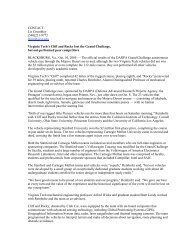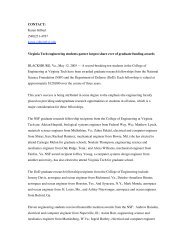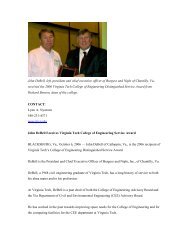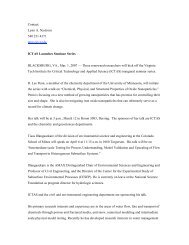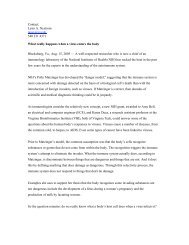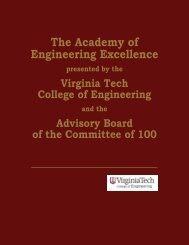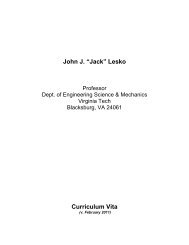NAVAL SURFACE WARFARE CENTER DAHLGREN ... - Virginia Tech
NAVAL SURFACE WARFARE CENTER DAHLGREN ... - Virginia Tech
NAVAL SURFACE WARFARE CENTER DAHLGREN ... - Virginia Tech
You also want an ePaper? Increase the reach of your titles
YUMPU automatically turns print PDFs into web optimized ePapers that Google loves.
<strong>NAVAL</strong> <strong>SURFACE</strong> <strong>WARFARE</strong> <strong>CENTER</strong> <strong>DAHLGREN</strong> DIVISIONCaptain Sheila Patterson, CommanderNEWS RELEASE(Contact: John Joyce/540-653-0365) Nov. 25, 2008Navy – <strong>Virginia</strong> <strong>Tech</strong> Agreement to benefit students and Navy<strong>DAHLGREN</strong>, Va. – <strong>Virginia</strong> <strong>Tech</strong> and the Naval Surface Warfare Center DahlgrenDivision (NSWCDD) signed a memorandum of understanding in Dahlgren, Va., Nov. 25,designed to develop and expand a framework of cooperation that will benefit theuniversity’s students and faculty in addition to Navy technology programs.The agreement will enable a framework of cooperation between <strong>Virginia</strong> <strong>Tech</strong> andNSWCDD to develop mutually beneficial innovative research projects and activities.“<strong>Virginia</strong> <strong>Tech</strong> is one of the state’s premier research and development institutions,” saidNSWCDD Commander Capt. Sheila Patterson. “Our ongoing relationship with theuniversity’s engineering department has already bolstered the development of crucialprograms from Electromagnetic Railgun to Nano <strong>Tech</strong>nology and we hope that this newagreement will further enhance our relationship with young scientists and engineers tobetter support the Navy.”“<strong>Virginia</strong> <strong>Tech</strong> is the Commonwealth’s leading research university, according to rankingsprovided by the National Science Foundation, and it is one of the preeminent leaders intechnological research in the country,” said Robert Walters, Vice President for Researchat <strong>Virginia</strong> <strong>Tech</strong>. “Our researchers are pushing the envelop of science, and theiroutstanding work led to the creation of <strong>Virginia</strong> <strong>Tech</strong>’s Institute for Critical <strong>Tech</strong>nologyand Applied Science (ICTAS).”Chris J. Cornelius, the Associate Director for Research, ICTAS, will lead the University’swork with the Navy. Cornelius joined the <strong>Virginia</strong> <strong>Tech</strong> engineering faculty after an eightyear stint at Sandia National Laboratories (SNL), a national facility operated for the U.S.Department of Energy by Sandia Corp.“Dr. Cornelius has achieved recognition and respect from industry and academiccommunities,” Walters added. “His research has been supported by more than $16million in competitive research awards, and he has three patents, with an additional twopending, all in the past seven years. He is an excellent choice to lead our pioneeringefforts with the Navy.”In today’s information rich environment, it is critical that the Navy stay abreast oftechnology and understand the realm of the possible for the future. Today’s academicinstitutions are key in being able to do this.
Moreover, in the current fiscally constrained environments, it is important for the Navyand academic institutions to look for more synergistic ways to continue providing cuttingedge technology to the warfighter with less funding using progressive relationships andagreements.This <strong>Virginia</strong> <strong>Tech</strong> – NSWCDD memorandum of understanding is supported by a varietyof longstanding partnership programs, comprising the Educational PartnershipAgreement, Naval Research Enterprise Intern Program, Summer Faculty ResearchProgram, Work for Others, Cooperative Research and Development Agreements, as wellas other contracts and grants.Collaboration and efforts to meet objectives in the performance of mutual innovativeresearch and activities may include:• Collaboration and management of innovative research projects.• Evaluation of existing technologies for innovative uses in the Naval environment• Access to and use of each party’s unique laboratories and facilities• Joint publication of studies, evaluations and lessons learned.• Acceleration and expansion of promising technologies for warfighter benefit• Joint innovative research in programs related to NSWCDD technical capabilitiesin dozens of areas from Chemical, Biological, and Radiological Warfare DefenseSystems and Directed Energy Systems to Human Systems Integration andNational Response Missions that include Homeland Security and DefensePhysical and Non-Physical Vulnerability Analysis.For more information, please visit the NSWCDD website at www.nswc.navy.mil, the<strong>Virginia</strong> <strong>Tech</strong> website at www.vt.edu, and the ICTAS website atwww.ictas.vt.edu/index.shtml- 30 -



